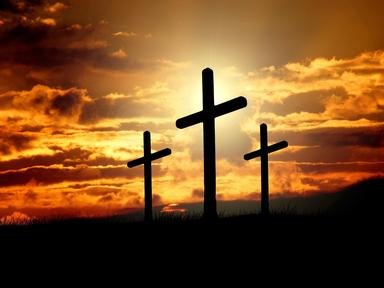Quiz Answer Key and Fun Facts
1. The photograph shows the statue of a winged lion in Venice, Italy. With which of the four evangelists is the winged lion associated?
2. The axe is the symbol of one of the Apostles. His feast day is May 14 in the Catholic and Anglican calendars and August 9 in that of the Eastern Orthodox. He is the patron saint of two U.S. cities: Gary, Indiana and Great Falls, Montana. Which apostle is this?
3. The photograph shows a 1611 painting by Peter Paul Rubens, part of his "Apostle Series" and currently displayed at the Prado in Madrid. The painting shows the elderly, bearded saint holding a Tau Cross, one of his symbols. His other symbols include a basket of loaves. Which of the apostles is this?
4. One of the most important ecclesiastical figures of the 4th century, he was bishop of Milan from 374 until his death in 397 and is now the patron saint of that city. His feast day is December 7 and his symbols include a whip, bones, an ox and a dove. Which saint is this?
5. Sometimes known as "The Great Martyr", in 305 she died just aged 17-18 at the behest of the pagan emperor Maxentius. She has many symbols including a sword, hailstones, a bridal veil and ring, a dove and a book. Her feast day is November 25. Who is this 3rd-century saint?
6. The symbol associated with this 9th-century saint is a quiver of arrows. His feast day is November 20, the date on which he was killed by Danes in battle. Which saint is this?
7. Depicted by many artists, our next saint was a 12th/13th-century Roman Catholic friar and preacher. The patron saint of Italy, his feast day is on October 4. One of history's most venerated religious figures, who is this saint?
8. Our next saint is often symbolized by fish, by an Archangel holding a bottle or flask, and by a young man carrying a fish or a staff. His feast day can be on either September 29 or October 24 and he is the patron saint of marriage, blind people and guardian angels. Who is this saint?
9. Symbolized by holding a bridge and by broken eggs at his feet, this 9th-century saint was the Anglo-Saxon Bishop of Winchester. Although historically important, it is his posthumous miracle-working for which he is most venerated. Which saint's feast day is July 15?
10. Our final saint is symbolized by stones due to the manner of his death, as depicted in the 15th-century fresco by Paolo Uccello. He is known as the Protomartyr", or the first martyr of Christianity, and the martyr's palm frond is another of his symbols. Who is this 1st-century saint?
Source: Author
EnglishJedi
This quiz was reviewed by FunTrivia editor
looney_tunes before going online.
Any errors found in FunTrivia content are routinely corrected through our feedback system.
